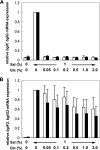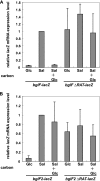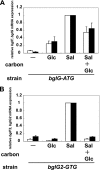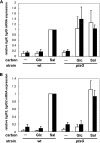Translation efficiency of antiterminator proteins is a determinant for the difference in glucose repression of two β-glucoside phosphotransferase system gene clusters in Corynebacterium glutamicum R
- PMID: 21075922
- PMCID: PMC3019825
- DOI: 10.1128/JB.01123-10
Translation efficiency of antiterminator proteins is a determinant for the difference in glucose repression of two β-glucoside phosphotransferase system gene clusters in Corynebacterium glutamicum R
Abstract
Corynebacterium glutamicum R has two β-glucoside phosphoenolpyruvate, carbohydrate phosphotransferase systems (PTS) encoded by bglF and bglF2 located in the respective clusters, bglF-bglA-bglG and bglF2-bglA2-bglG2. Previously, we reported that whereas β-glucoside-dependent induction of bglF is strongly repressed by glucose, glucose repression of bglF2 is very weak. Here, we reveal the mechanism behind the different effects of glucose on the two bgl genes. Deletion of the ribonucleic antiterminator sequence and transcriptional terminator located upstream of the translation initiation codon of bglF markedly relieved the glucose repression of a bglF-lacZ fusion, indicating that glucose affects the antitermination mechanism that is responsible for the β-glucoside-dependent induction of the bglF cluster. The glucose repression of bglF mRNA was also relieved by introducing a multicopy plasmid carrying the bglG gene encoding an antiterminator of the bglF cluster. Moreover, replacement of the GUG translation initiation codon of bglG with AUG was effective in relieving the glucose repression of bglF and bglG. Inversely, expression of bglF2 and bglG2 was subject to strict glucose repression in a mutant strain in which the AUG translation initiation codon of bglG2 encoding antiterminator of the bglF2 cluster was replaced with GUG. These results suggest that the translation initiation efficiency of the antiterminator proteins, at least in part, determines whether the target genes are subject to glucose repression. We also found that bglF expression was induced by glucose in the BglG-overexpressing strains, which may be explained by the ability of BglF to transport glucose.
Figures








Similar articles
-
Identification of a second beta-glucoside phosphoenolpyruvate: carbohydrate phosphotransferase system in Corynebacterium glutamicum R.Microbiology (Reading). 2009 Nov;155(Pt 11):3652-3660. doi: 10.1099/mic.0.029496-0. Epub 2009 Jul 23. Microbiology (Reading). 2009. PMID: 19628558
-
Protein phosphorylation regulates transcription of the beta-glucoside utilization operon in E. coli.Cell. 1989 Sep 8;58(5):847-55. doi: 10.1016/0092-8674(89)90937-9. Cell. 1989. PMID: 2673534
-
A single V317A or V317M substitution in Enzyme II of a newly identified beta-glucoside phosphotransferase and utilization system of Corynebacterium glutamicum R extends its specificity towards cellobiose.Microbiology (Reading). 2003 Jun;149(Pt 6):1569-1580. doi: 10.1099/mic.0.26053-0. Microbiology (Reading). 2003. PMID: 12777497
-
The glucose uptake systems in Corynebacterium glutamicum: a review.World J Microbiol Biotechnol. 2020 Jul 26;36(9):126. doi: 10.1007/s11274-020-02898-z. World J Microbiol Biotechnol. 2020. PMID: 32712859 Review.
-
The bgl sensory system: a transmembrane signaling pathway controlling transcriptional antitermination.Curr Opin Microbiol. 2005 Apr;8(2):127-34. doi: 10.1016/j.mib.2005.02.014. Curr Opin Microbiol. 2005. PMID: 15802242 Review.
Cited by
-
The lactose operon from Lactobacillus casei is involved in the transport and metabolism of the human milk oligosaccharide core-2 N-acetyllactosamine.Sci Rep. 2018 May 8;8(1):7152. doi: 10.1038/s41598-018-25660-w. Sci Rep. 2018. PMID: 29740087 Free PMC article.
-
The current riboswitch landscape in Clostridioides difficile.Microbiology (Reading). 2024 Oct;170(10):001508. doi: 10.1099/mic.0.001508. Microbiology (Reading). 2024. PMID: 39405103 Free PMC article. Review.
-
Genome-wide analysis of the role of global transcriptional regulator GntR1 in Corynebacterium glutamicum.J Bacteriol. 2014 Sep;196(18):3249-58. doi: 10.1128/JB.01860-14. Epub 2014 Jun 30. J Bacteriol. 2014. PMID: 24982307 Free PMC article.
-
Rho and RNase play a central role in FMN riboswitch regulation in Corynebacterium glutamicum.Nucleic Acids Res. 2015 Jan;43(1):520-9. doi: 10.1093/nar/gku1281. Epub 2014 Dec 4. Nucleic Acids Res. 2015. PMID: 25477389 Free PMC article.
-
Regulation of the Expression of De Novo Pyrimidine Biosynthesis Genes in Corynebacterium glutamicum.J Bacteriol. 2015 Oct;197(20):3307-16. doi: 10.1128/JB.00395-15. Epub 2015 Aug 10. J Bacteriol. 2015. PMID: 26260458 Free PMC article.
References
-
- Amster-Choder, O. 2005. The bgl sensory system: a transmembrane signaling pathway controlling transcriptional antitermination. Curr. Opin. Microbiol. 8:127-134. - PubMed
-
- Cote, C. K., D. Cvitkovitch, A. S. Bleiweis, and A. L. Honeyman. 2000. A novel beta-glucoside-specific PTS locus from Streptococcus mutans that is not inhibited by glucose. Microbiology 146:1555-1563. - PubMed
Publication types
MeSH terms
Substances
LinkOut - more resources
Full Text Sources
Molecular Biology Databases

